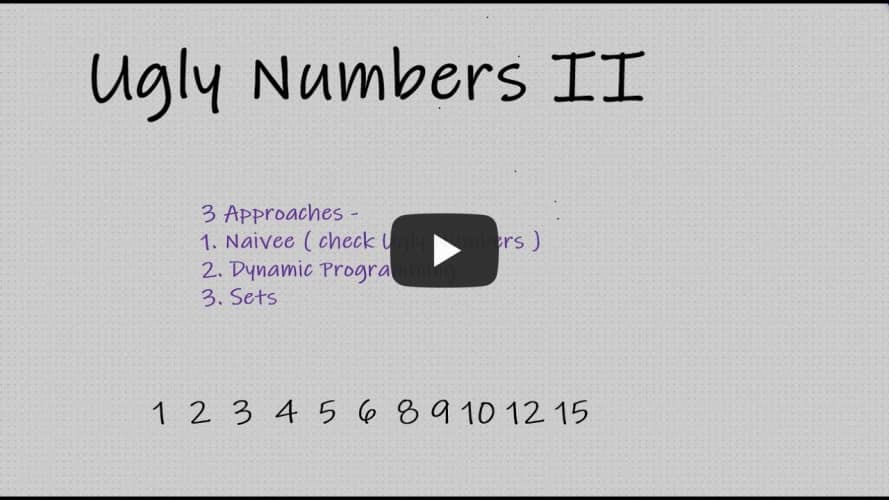6Companies30days
Ugly Numbers
An ugly number is a positive integer whose prime factors are limited to 2, 3, and 5. Given an integer n, return the nth ugly number.
Example
Input: n = 10
Output: 12
Explanation: [1, 2, 3, 4, 5, 6, 8, 9, 10, 12] is the sequence of the first 10 ugly numbers.
Video Explanation
Naive approach - to check for ugly numbers and keep building till the end ( exponential complexity ) ( O(n^n) )
vector <int> sieve;
bool checkUgliness(int n){
vector <int> ugliPrimes = {2,3,5};
for(auto prime:sieve) {
if( n % prime == 0 ) {
return false;
}
}
for(auto prime: ugliPrimes){
if( n % prime == 0 ) {
return true;
}
}
sieve.push_back(n);
return false;
}
int nthUglyNumber(int n) {
if( n == 1 ) return 1;
int uglyCnt = 1;
int i = 2;
int currUgly = 1;
while( uglyCnt < n ){
if(checkUgliness(i)) {
uglyCnt++;
currUgly = i;
}
i++;
}
return currUgly;
}
Using sets ( O(nlogn) )
- Idea is to maintain a set to quickly find the smallest element in O(logn) and maintain unique set.
triplets = {2,3,5}maintain a pointer to the minimum element- the current minimum element is the ith Ugly Number
- To find the (i+1)th Ugly Number multiply the current ugly number by 2,3,5 and push the triplet in the set and delete the current ugly number.
- Now revaluate the current ugly number from the set
- Be careful of overflows as
curr*5 > INT_MAX
Code -
int nthUglyNumber(int n) {
set <int> store = {2,3,5};
int ugly = 1;
int i = 2;
vector <int> triplets = {2,3,5};
while( i <= n ){
long int curr = *store.begin();
ugly = curr;
i++;
for( auto num : triplets) {
long int temp = curr*num;
if( temp > INT_MAX ) continue;
store.insert(temp);
}
store.erase(curr);
}
return ugly;
}
This approach can be improved by using a priority queue instead of a set.
Optimal Solution | DP | Prime Factors
Idea
The key is to realize each number can be and have to be generated by a former number multiplied by 2, 3 or 5
e.g. 1 2 3 4 5 6 8 9 10 12 15..
what is next?
it must be x * 2 or y * 3 or z * 5, where x, y, z is an existing number.
How do we determine x, y, z then? apparently, you can just traverse the sequence generated by far from 1 … 15, until you find such x, y, z that x * 2, y * 3, z * 5 is just bigger than 15. In this case x=8, y=6, z=4. Then you compare x * 2, y * 3, z * 5 so you know next number will be x * 2 = 8 * 2 = 16. k, now you have 1,2,3,4,….,15, 16,
Then what is next? You wanna do the same process again to find the new x, y, z, but you realize, wait, do I have to traverse the sequence generated by far again?
NO! since you know last time, x=8, y=6, z=4 and x=8 was used to generate 16, so this time, you can immediately know the new_x = 9 (the next number after 8 is 9 in the generated sequence), y=6, z=4. Then you need to compare new_x * 2, y * 3, z * 5. You know next number is 9 * 2 = 18;
And you also know, the next x will be 10 since new_x = 9 was used this time. But what is next y? apparently, if y=6, 6*3 = 18, which is already generated in this round. So you also need to update next y from 6 to 8.
Based on the idea above, you can actually generated x,y,z from very beginning, and update x, y, z accordingly. It ends up with a O(n) solution.
PS
- We have an array k of first n ugly number. We only know, at the beginning, the first one, which is 1. Then
- k[1] = min( k[0]x2, k[0]x3, k[0]x5). The answer is k[0]x2. So we move 2’s pointer to 1. Then we test:
- k[2] = min( k[1]x2, k[0]x3, k[0]x5). And so on. Be careful about the cases such as 6, in which we need to forward both pointers of 2 and 3.
- x here is multiplication.
int nthUglyNumber(int n) {
int two = 0 , three = 0 , five = 0 ;
vector <int> ugly(n+1,0);
ugly[0] = 1;
for( int i = 1 ; i <=n ; i++ ){
ugly[i] = min({ugly[two]*2 , ugly[three]*3 , ugly[five]*5 });
if(ugly[i] == ugly[two]*2 ) two++;
if(ugly[i] == ugly[three]*3 ) three++;
if(ugly[i] == ugly[five]*5 ) five++;
}
return ugly[n-1];
}
Credits -
